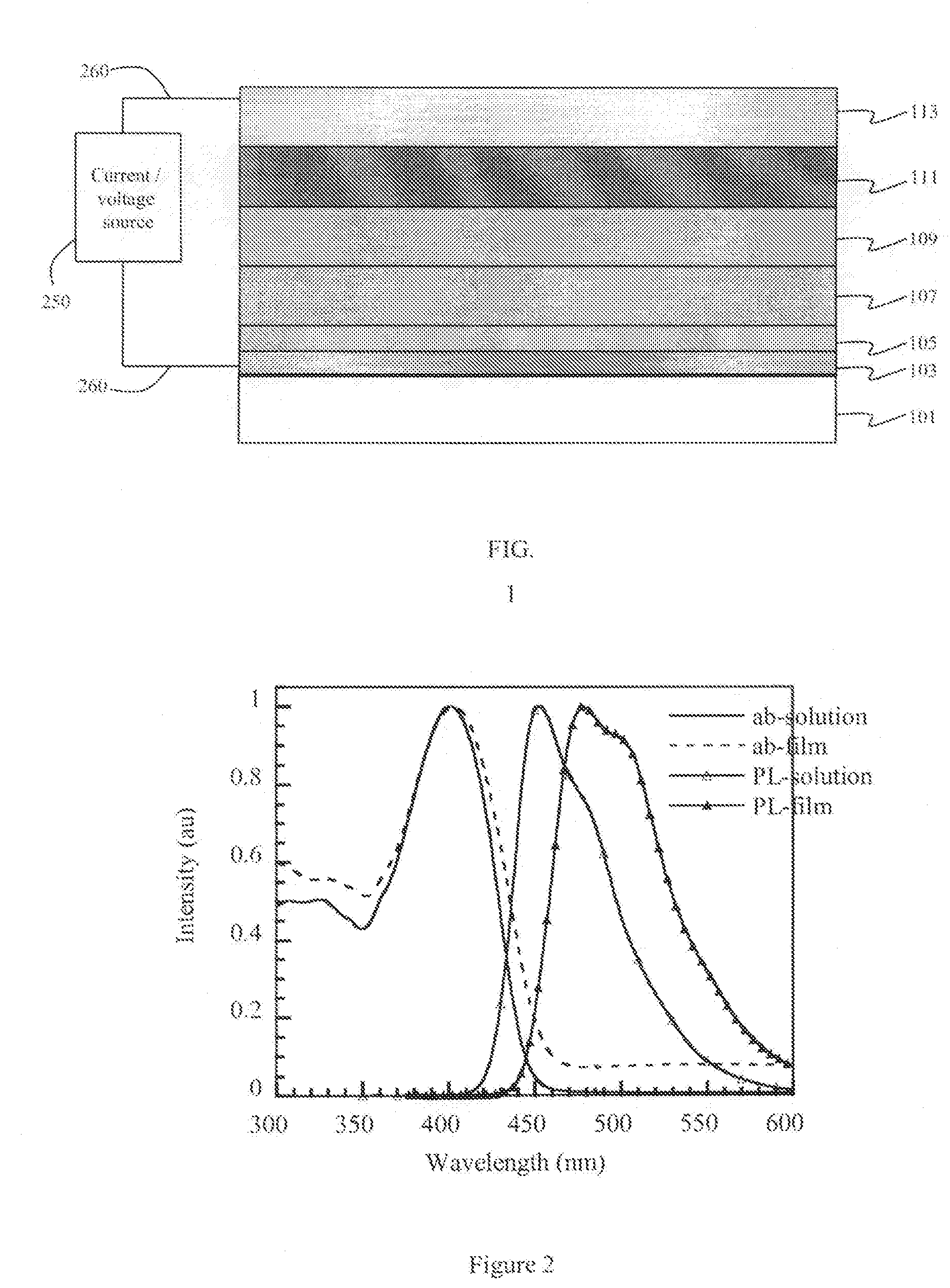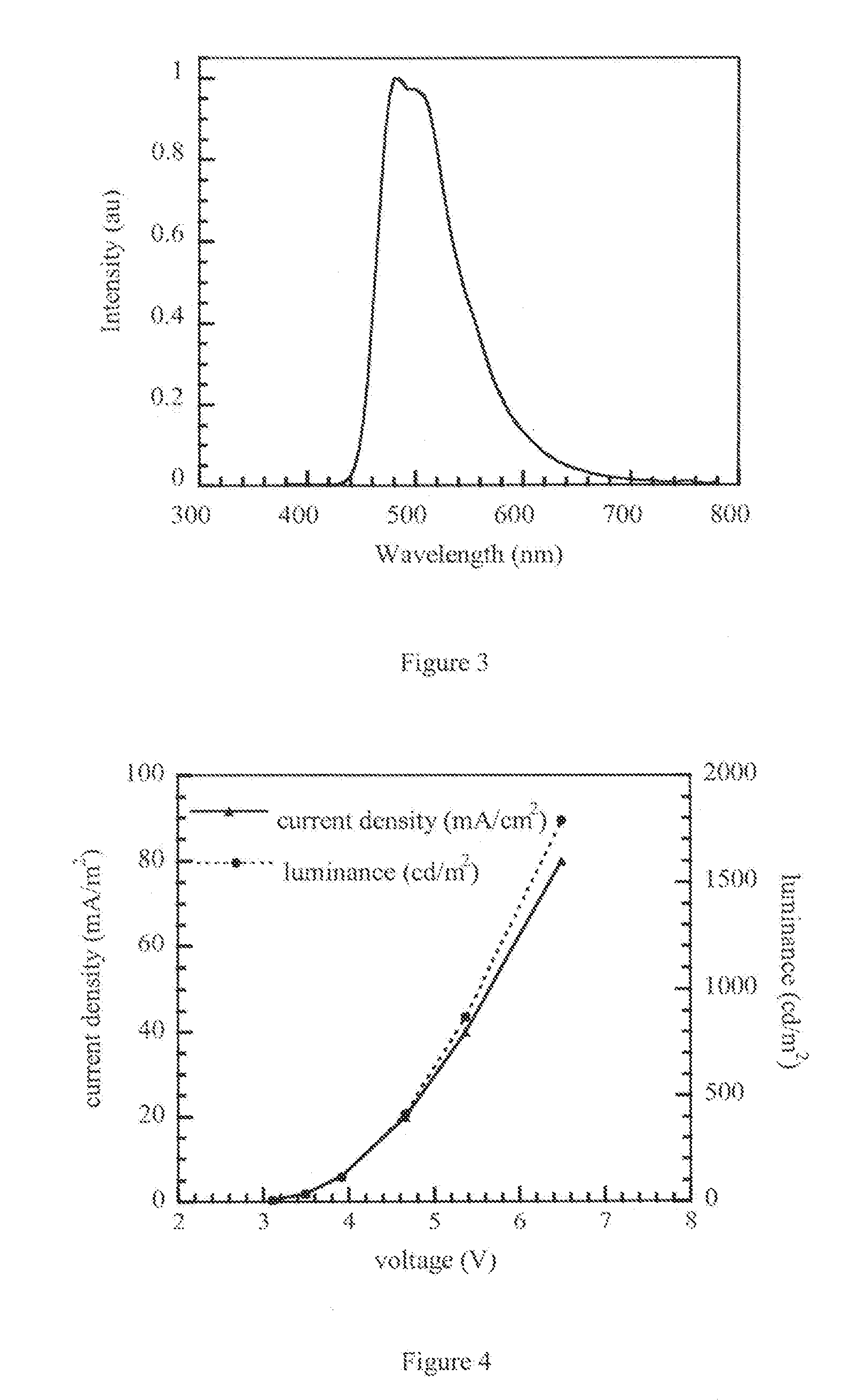6-member ring structure used in electroluminescent devices
a technology of electroluminescent devices and ring structures, which is applied in the direction of water-setting substance layered products, organic compounds of the group 3/13 element, transportation and packaging, etc., can solve the problems of insufficiently satisfying the needs of any of the existing technologies, difficult processing and obtaining large surface areas, and efficient blue light, etc., to achieve excellent solubility and thermal stability, good color tunability, and high efficiency
- Summary
- Abstract
- Description
- Claims
- Application Information
AI Technical Summary
Benefits of technology
Problems solved by technology
Method used
Image
Examples
example 1
Synthesis of Compound A
[0166]1-Bromo-5-benzyloxynaphthalene (10.0 g, 0.034 mol), 4-methoxyphenyl boronic acid (5.6 g, 0.037 mol), sodium carbonate aqueous solution (2 M, 13.6 mL), 2 drops of phase transfer reagent Aliquat 336, and toluene (100 mL) were mixed in a 250-mL round bottomed flask and degassed with nitrogen for 20 min. Catalyst Pd(PPh3)4 (0.02 mol %) was added and the reaction was heated to 90° C. overnight. The reaction was cooled down and extracted with ethyl acetate. The organic phase was dried over magnesium sulfate and concentrated. The crude product was purified by column on passing through a short silica gel column using methylene chloride as an eluent and recrystallized from heptane / ethanol to give 9.5 g of pure product as yellow solid (83% yield). 1H NMR (CDCl3) δ ppm: 3.92 (s, 3H), 5.31 (s, 2H), 6.93-6.96 (m, 1H), 7.06-7.09 (m, 2H), 7.36-7.58 (m, 11H), 8.44-8.49 (m, 1H); 13C NMR (CDCl3) δ ppm: 55.28, 70.15, 105.03, 113.60, 118.66, 121.40, 124.76, 125.68, 126.13, ...
example 2
Synthesis of Compound B
[0167]Compound A (9.0 g, 0.030 mol) was dissolved in methylene chloride and cooled to 0° C. for 20 min. To the solution was added boron tribromide (1 M in methylene chloride, 46 mL) dropwise. The reaction was stirred for 20 min. and quenched with saturated Na2CO3 solution, and extracted with methylene chloride. The crude product was purified by column chromatography on silica gel using 1 / 1 methylene chloride / heptane as an eluent to 3.8 g give pure product as light brown solid (50% yield). 1H NMR (CDCl3) δ ppm: 3.89 (s, 3H), 6.81 (d, J=7.2 Hz, 1H), 7.02 (d, J=8.6 Hz, 2H), 7.24 (t, J=7.3 Hz, 1H), 7.41 (d, J=8.5 Hz, 3H), 7.51 (t, J=7.5 Hz, 2H), 8.20 (d, J=8.3 Hz, 1H); 13C NMR (CDCl3) δ ppm: 55.35, 108.41, 112.96, 113.64, 118.91, 120.82, 124.74, 125.66, 127.54, 127.82, 128.76, 130.33, 131.08, 151.54, 158.82; FD-MS: 250 (M+).
example 3
Synthesis of Compound C
[0168]Compound B (2.8 g, 0.011 mol), 3,4-dibromoanisole (2.9 g, 0.0111 mol), cesium carbonate (5.6 g, 0.017 mol), triphenylphosphine (0.59 g, 0.002 mol) were dissolved in DMF and degassed with nitrogen for 20 min. Catalyst palladium acetate (0.125 g, 0.006 mol) was added and the reaction was heated to 160° C. overnight. Reaction was cooled down and water was added. The reaction was extracted with ether and the crude product was purified by column chromatography on silica gel using 1 / 9 ether / heptane as an eluent to give 1.0 g pure product as light green fluorescent solid (26% yield). 1H NMR (CDCl3) δ ppm: 3.84 (s, 3H), 3.88 (s, 3H), 6.63-6.71 (m, 2H), 6.90-7.02 (m, 3H), 7.27-7.52 (m, 6H), 7.73 (d, J=8.7 Hz, 1H); 13C NMR (CDCl3): δ5.32, 55.46, 101.36, 107.94, 110.69, 112.91, 113.83, 117.86, 118.28, 123.67, 127.02, 128.32, 130.64, FD-MS: 354 (M+).
PUM
| Property | Measurement | Unit |
|---|---|---|
| Mass | aaaaa | aaaaa |
| Mass | aaaaa | aaaaa |
| Mass | aaaaa | aaaaa |
Abstract
Description
Claims
Application Information
 Login to View More
Login to View More - R&D
- Intellectual Property
- Life Sciences
- Materials
- Tech Scout
- Unparalleled Data Quality
- Higher Quality Content
- 60% Fewer Hallucinations
Browse by: Latest US Patents, China's latest patents, Technical Efficacy Thesaurus, Application Domain, Technology Topic, Popular Technical Reports.
© 2025 PatSnap. All rights reserved.Legal|Privacy policy|Modern Slavery Act Transparency Statement|Sitemap|About US| Contact US: help@patsnap.com



